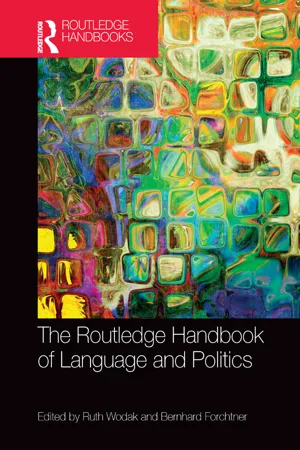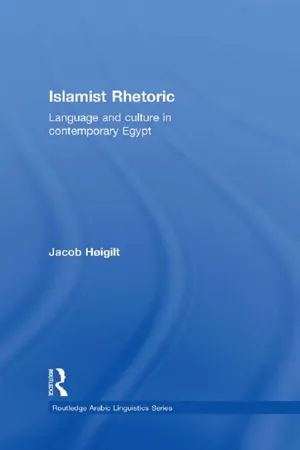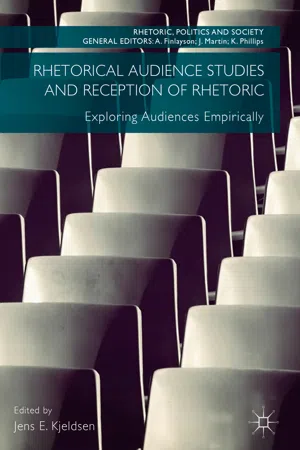Languages & Linguistics
Rhetorical Analysis
Rhetorical analysis is the examination of how language is used to persuade and influence an audience. It involves analyzing the strategies and techniques employed in written, spoken, or visual texts to understand their intended impact. This process often involves dissecting the use of language, structure, and appeals to emotion or logic to uncover the underlying persuasive elements.
Written by Perlego with AI-assistance
Related key terms
4 Key excerpts on "Rhetorical Analysis"
- eBook - ePub
- Ruth Wodak, Bernhard Forchtner, Ruth Wodak, Bernhard Forchtner(Authors)
- 2017(Publication Date)
- Routledge(Publisher)
Meynet describes Rhetorical Analysis as an activity or field that belongs to linguistics ‘by reason of its object, even if it also works beyond the limits of the sentence; it also belongs to it by reasons of its method and its procedures’ (Meynet 2012, p. 23). It shares many characteristics with different textual analysis approaches within linguistics. Thus, rhetorical and linguistic analysis often go hand in hand. Even if there is no such thing as a ‘linguistic rhetoric’, there are various approaches within linguistic communication and argumentation research that investigate persuasive strategies used by communication participants. These research activities could be viewed as ‘linguistic rhetoric’ (Kindt 2008, p. 147). In the context of political language it is possible to speak of politolinguistics as proposed by Reisigl: ‘Politolinguistics theoretically relies on actual concepts in political science, as well as on rhetorical and discourse-analytical categories […]’ (Reisigl 2008, p. 244). A thorough analysis of political language may benefit significantly from approaches connecting rhetoric, political science and linguistic discourse analysis (Wodak 2014a, p. 525). Rhetoric in politics today is much characterised by persuasiveness, because a democracy depends on agreements for decision-making processes. Thus, political discourse shaped by rhetoric has become an important field for Rhetorical Analysis. Because political decision-making processes are largely reliant on the willingness of people to agree, there is a strong preference for persuasive language. Most political interactions, as well as texts, are influenced by this preference and their lexis – as well as the structure of their speech acts – are formed by persuasive language (Klein 2009, p. 2113).Discursive approaches to Rhetorical Analysis
Researchers, referring to their own work as ‘rhetorical criticism or rhetorical theory’, unfortunately often are not familiar with the multidisciplinary field Critical Discourse Studies (Eisenhart & Johnstone 2008, p. 14). Discourse-centred approaches – with their major exponents, Ruth Wodak (Wodak & Chilton 2005; Wodak & Meyer 2001; Wodak 2012), Paul Chilton and Christina Schäffner (2002), Teun van Dijk (2008), and Isabella and Norman Fairclough (2012) – combine the traditional modes of rhetorical criticism with the tools of linguistic analysis.5 The Discourse-Historical Approach (DHA), for instance, is a three-dimensional model connecting ‘formal, functional and content-related aspects of argumentation in an integrative framework’ (Reisigl 2014, p. 69). The DHA specifically stresses the importance of the historical dimension in the analysis of political discourse. In this way, a multi-perspective interpretation of text is possible and intertextual, interdiscursive, diachronic as well as synchronic links can be drawn. Texts are never isolated, but are parts of greater temporal and spatial nexuses. Discourses overlap, and texts and genres thus are of a hybrid nature. Therefore, the DHA ‘facilitates looking at latent power dynamics and the range of potential in agents’ (Forchtner, Krzyżanowski & Wodak 2013, p. 211). The DHA aims at bringing to mind the relationship between power and language and at producing ‘enlightenment and support emancipation’ (Wodak & Köhler 2010, 36–37; Forchtner 2011, p. 2). The DHA criticises political language, and there is a special focus on right-wing and populist rhetoric (Wodak & de Cillia 2007; Wodak & Köhler 2010; Wodak 2014b). Topics of specific discourses, discursive strategies and the linguistic means by which they are constructed are analysed within the following five heuristic categories (Wodak 2001, p. 93). A focus on nomination, for instance, reveals how social actors or events (anthroponyms, tropes, etc.) are linguistically constructed. Predication refers to strategies, which attribute negative or positive characteristics to the social actors identified in a text, for example, via certain figures of speech, such as euphemisms or dysphemisms. In a further step, argumentative strategies, which are used to justify, for example, predications, are identified. In this step, topoi and argumentation patterns/fallacies are evaluated. By looking for mitigation/intensification, ways of modifying utterances are detected. Furthermore, strategies of perspectivation - eBook - ePub
Islamist Rhetoric
Language and Culture in Contemporary Egypt
- Jacob Hoigilt(Author)
- 2013(Publication Date)
- Routledge(Publisher)
2 Rhetorical Analysis and the study of social realityBy the text linguistic approach that is the methodological mainstay of this book I seek to connect rhetoric and social reality. This necessitates an at times rather technical analysis, so a somewhat detailed description of the conceptual apparatus is in order before embarking on the analysis.Rhetoric
Rhetoric is both an object of study and a category of analysis in this book. Let me explain both functions. Originally, rhetoric meant the civic art of public speaking in the Greek city-states (Kennedy 1994: 3), but the scope and use of the term have widened dramatically, especially since the new interest in it from the latter half of the twentieth century. For the purposes of this book, it is useful to turn to Peter Dixon's definition of a rhetor as ‘a man skilled in speaking who addresses a public audience in order to make an impact upon it’ (Dixon 1971: 2). If we include the word ‘writing’ in addition to ‘speaking’, this definition covers the three rather diverse discourses under study here. ‘Amr Khālid, Yūsuf al-Qaraḍāwī and Muḥammad ‘Imāra make an impact in the Egyptian Islamic space as writers and speakers, each in their own way. They address the Egyptian and Arab public with the aim of influencing their actions and/or beliefs, and seem to have considerable success in this enterprise. Further qualifications are, however, necessary, considering the fact that the scope of rhetoric has become so wide that it can embrace the ‘entire area of human discourse’ (Dixon 1971: 2). Already in the fourth century BC , Aristotle distinguished between three areas of persuasion: deliberative, judicial and epideictic (concerned with demonstrating someone's or something's excellence; Aristotle 1991). In a modern context, Robert and Susan M. Cockcroft's (1992) distinction between literary and functional - eBook - ePub
- Kirsten Malmkjaer, Kirsten Malmkjaer(Authors)
- 2009(Publication Date)
- Routledge(Publisher)
Much linguistic research involves the analysis of data obtained through observational or experimental approaches to language in use and requires both quantitative and qualitative analytical techniques. All well-planned, well-executed and well-analysed linguistic research provides fascinating insights into the myriad ways that individuals use language. Surely, such an important aspect of human communication, indeed some claim that human ability to use language is one of the defining characteristics of humanity itself, deserves to be researched as carefully and as accurately as possible so that there is evidence to support the claims being made.A. B.Suggestions for further readingWray, A and Bloomer, A (2006) Projects in Linguistics, 2nd edn, London: Routledge.Rhetoric
Rhetoric is an ambiguous term. Among other things, it refers to an ancient discipline with an uneven, complex history, an activity connected to the pragmatic dimension of language, a body of precepts about that activity, a teaching tradition dedicated to the cultivation of citizens who have the capacity to speak and write persuasively, and a mode of critical analysis designed to help citizens resist symbolic techniques of repression.Confronted with this ambiguity, rhetoricians have not been able to settle themselves within tidy disciplinary borders but have manoeuvred around a set of permanently unsettled basic questions: is rhetoric a global symbolic activity that pertains to all discourse and that invites inquiry into the means by which discourse achieves its purposes? Or should it be conceived as a more limited activity that operates within the domain of civic affairs and that implicitly or explicitly connects with a set of ethical and political values? Is rhetoric an ‘art’ (i.e. a more-or-less systematic body of principles) that provides the means for effecting persuasion and/or standards for assessing the effectiveness of efforts at persuasion? Or is rhetorical activity too diffuse and too contingent on particular occasions and circumstances to allow for such systematisation? Is rhetoric best conceived as the study of how human agents attempt to influence others? Or is it best approached from the receiver’s perspective? Should rhetoric concentrate on particular encounters? Or should it privilege larger discursive formations? Is it possible or desirable to treat rhetoric as method that operates technically and indifferently on the subjects it treats? Or are method and subject – form and content – so intimately linked as to be inseparable? - eBook - ePub
Rhetorical Audience Studies and Reception of Rhetoric
Exploring Audiences Empirically
- Jens E. Kjeldsen, Jens E. Kjeldsen(Authors)
- 2017(Publication Date)
- Palgrave Macmillan(Publisher)
2003 ).Not only are rhetorical texts polysemic , it can be difficult to determine exactly what and where the rhetorical text is. While traditional rhetorical criticism analysed discrete and clearly demarcated texts, a researcher in our contemporary and fragmented media environment will often find it challenging to determine which text an audience has actually experienced (Kjeldsen 2008 )—or even who the audience is (Livingstone 2004 ; Radway 1988 ; Tindale 2013 ). This is especially pertinent online where communication is constantly produced, copied, shared and changed. Online communication is interactive, intertextual and transitory. It is increasingly segmented and personalized by the use of algorithms, creating different texts for different groups—even for individuals. In this situation, the best way of finding out which texts—or rather flow of communication—people have experienced is to talk to them or observe them.Audience studies not only help us see that texts are polysemic and audiences are active, but also that audience interpretation and decoding are not completely free and incidental (Condit 2013 ). Audience studies, then, are not only a way of understanding the power of the audience, it is also a way of understanding the power of rhetoric—in situ and in general.Audience and reception studies also offer a way to understand “the other”. If we truly wish to understand the persuasiveness of appeals we find surprising, or even worrisome, we will not find good answers by speculating about the values or (lack of) intelligence of the audience. If we seek answers only by putting ourselves in the place of “the other”, playing the role of people different than ourselves, we will neither understand them nor the rhetoric they find appealing. It is obvious, for instance, that the rhetoric of Donald J. Trump in the US election campaign of 2016 was received very differently by supporters and opponents. To many, the appeal and success of Mr. Trump’s rhetoric was surprising, almost inexplicable. The answers could have been found by paying more attention to the audiences that found his rhetoric convincing, for instance, through studies of the reception of his speeches and tweets.
Index pages curate the most relevant extracts from our library of academic textbooks. They’ve been created using an in-house natural language model (NLM), each adding context and meaning to key research topics.



